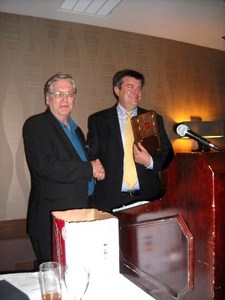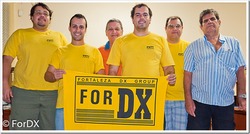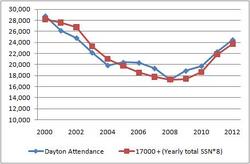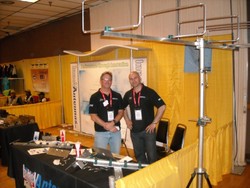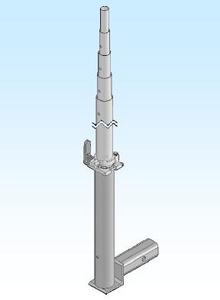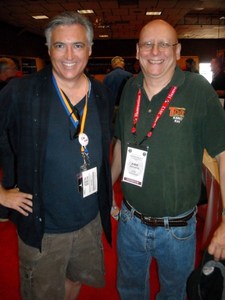 June 6, 2012 Editor: Ward Silver, NØAX | |||||||||
IN THIS ISSUE
NEW HF OPERATORS - THINGS TO DO Along with the many VHF+ contests hoping to "catch a wave" during sporadic E season, check out the All-Asian CW contest to pick up some contacts from the other side of the globe! On phone, Kids Day is all about satisfying the curiosity of a youngster or two who wants to see what this ham radio business is all about. Spend a few hours enjoying ham radio with them! BULLETINS There are no bulletins in this issue. BUSTED QSOS My log-checking report is full! Katie is WY7KRA not KRB, John is K9JK not N9JK. (Thanks, Katie WY7KRA, Trey N5KO, and Phil N9KAH) CONTEST SUMMARY Complete information for all contests follows the Conversation section June 9-10
June 16-17
ARRL VHF+ contests have new names beginning immediately! From ARRL Contest Branch Manager, Sean KX9X, "The June VHF QSO Party has a long history but we felt it was time the name of the event properly reflected what it was: a contest. We're still working out all the details in the Contest Branch and on the ARRL website to get everything properly converted, but you will soon see references to the January, June and September ARRL VHF Contests, not QSO Parties or Sweepstakes." (No change is required to submit a log since the Cabrillo-format CONTEST: name for these events does not refer to "QSO Party" or "Sweepstakes".) The Packrats and the Northeast Weak Signal (NEWS) VHF clubs are sponsoring a VHF conference on October 12, 13 and 14, in Bensalem, PA. Early-bird rates are available and all details are online on the Packrats website. Papers and presentations are requested on any and all topics related to VHF+ communication, theory, construction, operation, antennas, contesting, safety, modes, EME, digital techniques and more. Send your submission to Rick, K1DS.
At the Dayton Hamvention, WRTC2014 Chairman Doug Grant, K1DG reported on the progress of one of WRTC2014's popular fund-raising opportunities - Tent Sponsorship in which a club donates a modest sum to help acquire all the necessary equipment to support a WRTC station. In return, the club logo is displayed on the tent and the club is acknowledged in the event's promotional material. Several large clubs have already committed to sponsoring multiple tents: YCCC, NCCC, and PVRC are leading the way with three tents each. Non-club groups can also participate by sponsoring a tent in the memory of a contester whose key has gone silent. Tents are already being sponsored to honor fallen comrades W4AN, N6ZZ, K5KA, W4AI/ZD8J, W2PV, KC1F, W5ZL, KL7FH & KL7Y, and I2UIY. The Daily DX reports that the 2013 Visalia International DX Convention will be changing venues from the Holiday Inn near Highway 99 to the larger Downtown Visalia Conference Center and adjacent Marriott Hotel. The dates remain the unchanged from those previously announced - April 19-21, 2013. The convention website still refers to the Holiday Inn as the venue but keep an eye on the site for updates. Hotel reservations should be available through the convention website beginning the week of June 18th. Scott W3TX contributed the following information from PROMED regarding ticks and Lyme disease, the bane of Beverage walkers and antenna farm builders. "While ticks normally become active in spring, this year's [2012] mild winter has brought them out earlier than normal. Although the adults, which are actively feeding now, can transmit the disease, CDC reports that most humans are infected by immature ticks known as nymphs, which feed spring through summer. When it comes to preventing tick bites, there are several precautions a person can take. The best way to minimize the threat of Lyme disease is to keep contact with the bloodsuckers to a minimum. This can be done by avoiding places where they are most likely found, including wooded and bushy areas, or areas with high grass. If you do anticipate contact with one of these high risk areas, it's important to wear a hat, long sleeves and pants, and to use insect repellant containing 20 per cent or more DEET on the exposed skin," Dr Kara Mascitti said. "It's also important to do a thorough tick check when returning indoors to remove any ticks that might have gotten on you despite these measures. Showering immediately upon returning indoors can also wash away ticks that haven't yet attached to the skin. If you do find a tick on you, the best way to remove it is to grab it as close to the skin as possible and pull up with a steady, consistent motion. Afterward, wash your hands and the bite area thoroughly with rubbing alcohol or soap and water. As for clothing and gear that comes in contact with the body such as backpacks, it's a good idea to treat them with a permethrin-based product designed to kill and repel ticks. CDC also recommends putting clothes in the dryer for one hour on high heat to kill any ticks that may be on them." The full article is available online.
The PW7T team had a good time in the recent CQ WPX CW contest with a goal of avoiding band-change errors that cost them a place in the standings last year. How did they do? You can read all about it in their writeup about the contest at the Forteleza DX Group's website. (Thanks, Luc PY8AZT) One-day "university" events are popping up all over as hams flock to opportunities to learn about technical and operating subjects. The best-known is Contest University but any hamfest or convention is liable to feature classes. For example, at the upcoming W9DXCC convention, they are sponsoring an all-day training event, "DX'ing from the Black Hole", held on the day before the main convention and aimed specifically at new and inexperienced DXers. This type of course adds real value to hamfests and flea markets, encouraging hams to spend a day learning something new and useful. Perhaps offering classes like this would enliven a hamfest near you? Hi-Z Antennas has reached a licensing agreement to resume selling their receiving antenna arrays. The company had been entangled in a patent dispute, now apparently resolved.
Gene Zimmerman W3ZZ became a Silent Key on 3 June at the age of 71. Gene was a giant in the world of radiosport. Not only was he an excellent and knowledgeable operator, but worked tirelessly behind the scenes as a member of contest committees and advisory groups. QST readers probably know him best as the editor of "The World Above 50 MHz" column, with sharp analysis of propagation and events. His many friends will miss his legendary story-telling and the gleam in his eye as he skewered miscreants. Bob N6TV has published an album of W3ZZ photos for the enjoyment and remembrance of all. See the Results and Records section of this newsletter for news about two new awards created to honor Gene. Web Site of the Week - If you would like to find out more about the stations you hear in contests, Pete N4ZR reports that his website "World HF Contest Station Database" is "back from the dead" and waiting for your station updates! My info was certainly out of date but is now current. (Thanks, Bob N6TV) WORD TO THE WISE Recent editions of the ARRL Handbook and ARRL Antenna Book include a CD-ROM with plenty of supplemental material and software. In particular, the Handbook's CD-ROM includes three complete chapters on operating: Space, Digital, and Image. You'll find a Smith Chart tutorial on the Antenna Book's CD along with handy software like HFTA and TLW, too. Check 'em out! For those who missed the Dayton Top Band Dinner, Frank W3LPL's presentation "1921 Transatlantic Tests, Progenitors to Modern Top Band Contests and DXing" is available on-line.
What happens after a 2000-foot tower falls? (Yes, it made a sound...) As Bob N6TV found, "This 27-minute video takes you through every step, from the original construction, to the failure (due to ice), to the construction and installation of its replacement less than a year later. It's pretty cool to see every step of the big tower construction, from steel fabrication, to galvanizing, to cable manufacture, and then to the final installation and power-up of the transmitters." Results for the record-breaking 2011 ARRL 10 Meter Contest are now live on the ARRL Contest Branch results website. Record scores through 2011 are also posted. The 2012 RTTY Roundup and January VHF Sweepstakes extended results are also online. Thanks to our new writeup authors Scott K7ZO (10 Meter) and Kevin W9GKA (Jan VHF) for great writeups along with old pro, Jay WS7I (RTTY Roundup). (Thanks, ARRL Contest Branch Manager, Sean KX9X) Speaking of VHF+ contests, certificates for the 2011 ARRL June VHF Contest are arriving in mailboxes across the land. There was a bit of a surprise for the winners this year - completely redesigned certificates with cool graphics and a new layout - each contest will have its own four-color certificate! (Thanks, Sean KX9X) Two new VHF contest operating awards honoring Gene W3ZZ have been created just in time for his favorite VHF+ operating event, the ARRL June VHF Contest. Tim K3LR and Dave W9ZRX are sponsoring the brand-new W3ZZ Rookie Award for the top Single-Op, Low Power score made on a minimum of two bands by a "rookie" submitting a log in the contest for the first time (no limit on how long the operator has been licensed). In addition, as Gene was a long-time member of the K8GP Grid Pirates who frequently operated in the Limited Multioperator category, the ARRL Contest Branch has renamed the Overall Limited Multioperator plaque the Gene Zimmerman, W3ZZ Memorial Plaque and thanks Jeff K1TEO, who graciously gave up his sponsorship of the plaque to allow this to happen. As these awards have just been announced, watch the ARRL Contest Branch website for any further information or answers to questions. The January 2012 NAQP CW preliminary results are now available on the NCJ website. Congratulations to N9RV for his first place single-op finish and new all-time record (breaking his own record). The top five scores broke the existing record. Many other state records were also set. SSB results should be available shortly. (Thanks, Bruce WA7BNM) 2011 California QSO Party results have also made their online debut along with updated records. The data, charts, and reports were prepared by K6TD, AD6E, and K6MM. (Thanks, Al AD6E) The final results for the 2011 New York QSO Party have been posted at. In addition, there is a full listing of 2011 plaque winners. Participation in 2011 was great and all are looking forward to the 2012 NYQP on October 20. (Thanks, Dean NW2K)
Following the announcement that 2012 Dayton Hamvention attendance was 24,483 and based on extensive research and modeling, Doug K1DG has determined "17000 hams will show up if there are no sunspots. For every uptick of 1 in the total SSN for the year, 800 more will attend." So get out those Cycle 24 predictions and start your hotel reservation planning! OPERATING TIP During WPX CW we heard many examples of why using "cut numbers" is not such a good idea. Cut numbers increase the chances of copying errors. They really don't save much time and what's saved is often lost again due to repeats and fills. Nevertheless, here are some of Jim K8MR's guidelines for using them...if you must: Don WD8DSB recently built two W7IUV preamps and has documented the project online which might be useful for others considering building the preamp. He used the W7IUV double-sided circuit board method and has artwork for the board at a 1:1 scale along with a parts placement guide that can be downloaded in PDF document format.
Stew K3ND reports very good results from reinforcing a CushCraft 40-2CD according to the W6NL modifications. This antenna has survived ice, heavy wet snow, and high winds. The newer model CC XM-240 can be strengthened in the same way. Amphenol UHF connectors are often recommended as "best practice" for coaxial cables at HF (although there are some good versions available from other vendors). There are quite a few variations, though - to be sure you know which one to get, go to the Amphenol website where you can view the complete line, including installation instructions (good for just about all UHF connectors), drawings, detail specifications, and even check distributor stock and inventory. Frank W3LPL notes that the base part number for a PL-259 from Amphenol is 83-1SP and anything after the "P" indicates a variation from the standard connector. (Thanks, Gary K9GS) The bidirectional Beverage antenna was patented by Harold Beverage in 1922. When he built the huge RCA receiver site at Riverhead, Long Island, the Beverages were built as bidirectional using a passive combiner with variable amplitude and phase to provide steerable deep nulls off the rear of the array. The antenna is described in this seminal article "The Wave Antenna" published in 1923. Perhaps the largest steerable phased Beverage array ever built was the four-Beverage array at AT&T's transatlantic radiotelephone site in Houlton, Maine, straddling present day I-95 a few miles west of the Canadian border. (Thanks, Frank W3LPL) Just in time for the summer's sporadic E season comes a timely item by Bruce KØYW in ARRL Propagation Bulletin ARLP018 about noise figure and preamps on 6 meters. "At 6 Meters and below the employment of a preamp ahead of most modern transceivers is not likely to result in any noticeable improvement as the ambient thermal noise from the earth and sky background is high enough to readily overcome the sensitivity threshold of the existing receiver's RF stage/s, especially if the myriads of local man-made noise sources are added in. It is this combination of factors that will establish the 'Noise Floor' that the radio sees." Bruce goes on to explain why preamps are rarely useful at HF and on 6 meters - the original bulletin has more information. Technical Web Site of the Week - From the ARRL Propagation Bulletin ARLP021, Don NJ2E alerted us to the National Air and Space Lecture Series including one titled "The Solar Dynamics Observatory: The Sun Up Close and Personal". Click on the View Archived Recording link to watch the 71-minute video. Thailand - Coming Alive on HF At Last Following 2011's devastating flooding in Thailand, Thai hams displayed tremendous ham spirit and skill in assisting with disaster relief. Even limited to VHF, their skills were obvious to the authorities who had long resisted opening the HF airwaves except to a select few clubs and individuals. Long-time Thai licensee, Fred K3ZO (also known as HSØZAR) has been following developments closely and has some good news to share with readers of the Contest Update. It may not be very long before we hear more and more new Thai call signs on the HF bands! 73, Ward NØAX The long-awaited Thailand Amateur Radio Intermediate Class license exam -- the gateway to HF privileges for Thai licensees -- was held on May 19. This is the first time the examination has been given since November 27, 2004. So for over seven years Thailand's roughly 150,000 - 175,000 Novice licensees had been limited to Novice Class privileges, which amount to 10 watts on 2 meter channelized FM.
Unlike most countries in the world, Thailand has not abolished the Morse exam and in fact the first part of the exam to be given was the 8 wpm Morse receiving test, which only 43 out of 151 examinees (including 3 YLs) passed. Those 43 were allowed to take the written exam which will be graded by Thailand's NBTC, that country's equivalent of the FCC. The results will be known in about a month and apparently a public ceremony will be held to acknowledge the accomplishment of these folks. From my vantage point as a close observer and sometime participant in Thailand's ham radio affairs for the past 44 years, I feel strongly that this event is a real milestone in Thailand's ham radio progress, for the following reasons: 1) For a national radio society, RAST (Radio Amateur Society of Thailand) has long been top-heavy with foreign-born member participation. While Thai hams were required by Thai regulations to join RAST in order to receive their Intermediate Class licenses, few showed up at meetings to participate actively in club affairs. Under the new and dynamic leadership of RAST's current president, Prof. Pornchai ("Joe") Semjang HS2JFW, this is changing. The preparations and arrangements for this examination session were all done by Thai hams, including the setting up of the venue, coordination with the NBTC and drawing up of the question pool. This is not to minimize in any way the importance of the roles of Joe's two immediate predecessors Mayuree Chotikul HS1YL, who skilfully navigated the Society through troubled waters in very difficult political times, and Chaiyong Wongwuticomjon HS1QVD, who carefully prepared RAST for the newly enlarged role it has assumed in the modern era and whose great vision brokered the ascension of Joe to the presidency. 2) It was a tremendous accomplishment for the organizers of this examination to bring together virtually the entire corps of experienced Thai-national CW HF DXers to handle the Morse part of the examination. These are precisely the folks that RAST needs to have managing its affairs because of their close understanding of HF operations and international regulations and customs. Few of them had been active participants in RAST affairs before this. Hopefully this will encourage them to continue their participation. 3) The close cooperation between the NBTC and RAST in this event augurs well for the future. To a certain extent such cooperation in the recent past was made difficult by the very slow evolution that Thailand's regulatory body had to undergo. All along it was hampered by political uncertainty and so organizational inertia was often a logical response to such dilemmas. Now that the NBTC has finally been fully and legally constituted, impediments to future such cooperation will hopefully be minimized.
4) I would be remiss if I were not to mention the behind-the-scenes work in support of RAST's efforts over many years by the Thai Army's Maj. Narissara Shaowanasai HS1CHB. His uncanny knack for recognizing the leadership qualities of people like Joe and Champ E21EIC and picking them out of the crowd to propel them into becoming active and effective RAST officers cannot be overemphasized. Does the fact that the Morse exam eliminated so many candidates right off the bat mean that Thailand will move to follow other countries and eliminate Morse as an examination requirement? Not necessarily. Please read the article on the RAST website about the examination written by Champ E21EIC. You can detect a certain pride that Thailand is one of the few countries in the world still having a Morse exam requirement and a feeling on his part that many more candidates came close to passing the Morse exam and will be motivated to work on their CW. A brief video montage about the session is on YouTube. Now that RAST has demonstrated the fact that it can assemble a pool of talented Morse operators to give that part of the exam, I predict that exams will get back to being held on a regular basis again. 6 June through 19 June 2012 An expanded, downloadable version of QST's Contest Corral in PDF format is available. Check the sponsor's Web site for information on operating time restrictions and other instructions. HF CONTESTS SNS and NS Weekly Sprints--CW,Digital, from Jun 8, 0200Z to Jun 8, 0300Z. Bands (MHz): 1.8-14. Exchange: Serial number, name, S/P/C. Logs due: none. Rules WFF Green Days--Phone,CW,Digital, from Jun 9, 0000Z to Jun 10, 2359Z. Bands (MHz): 1.8-28. Exchange: RS(T) and WFF number if available. Logs due: 30 days. Rules DRCG Long Distance Contest--Digital, from Jun 9, 0000. Multiple operating periods. Bands (MHz): 3.5-28. Exchange: RST, CQ Zone, and UTC time. Logs due: Aug 1. Rules Australian Shires Contest--Phone,CW, from Jun 9, 0600Z to Jun 10, 0600Z. Bands (MHz): 3.5-28. Exchange: RS(T) and VK Shire or CQ Zone. Logs due: Sep 1. Rules Asia-Pacific Sprint--Phone, from Jun 9, 1100Z to Jun 9, 1300Z. Bands (MHz): 14-21. Exchange: RST, serial. Logs due: 7 days. Rules Portugal Day--Phone,CW, from Jun 9, 1200Z to Jun 10, 1200Z. Bands (MHz): 3.5-28. Exchange: RS(T) and serial or district code. Logs due: Sep 1. Rules GACW WWSA CW DX Contest--CW, from Jun 9, 1500Z to Jun 10, 1500Z. Bands (MHz): 3.5-28. Exchange: RST, CQ zone. Logs due: Jul 30. Rules http://www.wwsatest.org NAQCC Monthly QRP Sprint--CW, from Jun 13, 0030Z to Jun 13, 0230Z. Bands (MHz): 3.5-14. Monthly on 2nd Tuesday or 3rd Wednesday local time (alternating). Exchange: RST, S/P/C, and NAQCC mbr nr or power. Logs due: 4 days. Rules CWops Monthly Mini-CWT Test--CW, from Jun 13, 1300Z. Multiple operating periods, twice monthly on 2nd and 4th Wed, 18 to 28 kHz above band edge. Bands (MHz): 1.8-28. Exchange: Name and member number or S/P/C. Logs due: 2 days. Rules All-Asian DX Contest--CW, from Jun 16, 0000Z to Jun 17, 2400Z. Bands (MHz): 1.8-28. Exchange: RST, operator age (YL may send 00). Logs due: Jul 31. Rules SARL Youth Day Sprint--Phone, from Jun 16, 0800Z to Jun 16, 1000Z. Bands (MHz): 7. Exchange: RS and age. Logs due: 7 days. Rules Stew Perry Warmup Contest--CW, from Jun 16, 1500Z to Jun 17, 1500Z. Bands (MHz): 1.8. Exchange: 4-char grid square. Logs due: 30 days. Rules QRP ARCI QRP Shootout--Phone,CW, from Jun 16, 1500Z. See website. Bands (MHz): 1.8-28. CW on Saturday, SSB on Sunday. Exchange: Category, ARRL/RAC section or DX. Logs due: 14 days. Rules West Virginia QSO Party--Phone,CW,Digital, from Jun 16, 1600Z to Jun 17, 0200Z. Bands (MHz): 3.5-28. Frequencies: CW--35 kHz from band edge, Phone--35 kHz from General/Nov/Tech segments. Exchange: RS(T), WV county or S/P/C. Logs due: Jul 20. Rules Kid's Day--Phone, from Jun 16, 1800Z to Jun 16, 2400Z. Bands (MHz): 3.5-28. Exchange: Name, age, location, favorite color. Rules Feld-Hell Field Day Sprint--Digital, from Jun 16, 2000Z to Jun 16, 2200Z. Bands (MHz): 28. Monthly on 3rd Saturday. Exchange: RST, S/P/C, Feld-Hell member nr. Logs due: 7 days. Rules Run For the Bacon--CW, from Jun 18, 0200Z to Jun 18, 0400Z. Bands (MHz): 1.8-28. Monthly on 3rd Sunday night (local). Exchange: RST, S/P/C, Flying Pig nr or power. Rules VHF+ CONTESTS ARRL June VHF QSO Party--Phone,CW,Digital, from Jun 9, 1800Z to Jun 11, 0300Z. Bands (MHz): 50+. Exchange: Grid square. Logs due: Jul 11. Rules REF DDFM Six Meter Contest--Phone,CW, from Jun 9, 1600Z to Jun 10, 1600Z. Bands (MHz): 50. Exchange: RST, serial number, grid square. Logs due: 15 days. Rules SMIRK QSO Party--Phone,CW, from Jun 16, 0000Z to Jun 17, 2359Z. Bands (MHz): 50. Exchange: Grid square and member number. Logs due: Aug 1. Rules WAB 50 MHz Phone--Phone, from Jun 17, 0900Z to Jun 17, 1500Z. Bands (MHz): 50. Exchange: RS, serial, WAB square or DXCC entity. Logs due: 21 days. Rules LOG DUE DATES 6 June through 19 June 2012
ARRL Information Click here to advertise in this newsletter. Your One-Stop Resource for Amateur Radio News and Information ARRL membership includes QST, Amateur Radio's most popular and informative journal, delivered to your mailbox each month. Subscribe to NCJ - the National Contest Journal. Published bimonthly, features articles by top contesters, letters, hints, statistics, scores, NA Sprint and QSO Parties. Subscribe to QEX - A Forum for Communications Experimenters. Published bimonthly, features technical articles, construction projects, columns and other items of interest to radio amateurs and communications professionals. Free of charge to ARRL members: Subscribe to The ARRL Letter (weekly digest of news and information), the ARES E-Letter (monthly public service and emergency communications news), Division and Section news -- and much more! ARRL offers a wide array of products to enhance your enjoyment of Amateur Radio. Visit the site often for new publications, specials and sales. Donate to the fund of your choice -- support programs not funded by member dues! Reprint permission can be obtained by sending email to permission@arrl.org with a description of the material and the reprint publication. ACKNOWLEDGEMENTS ARRL Contest Update wishes to acknowledge information from WA7BNM's Contest Calendar and SM3CER's Contest Calendar. | |||||||||
